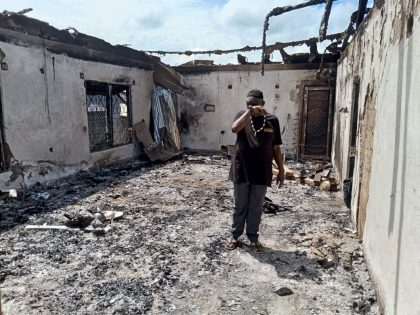Cape Town Gangster Films
If you wish to gain some insight into the turmoil of gangland Cape Town, it's worth starting with the films of Riaan Hendricks and Dylan Valley.

Braaim, the protagonist of Riaan Hendricks' "The Devil's Lair" (Still from the film).
In both print and film Cape Flats gangsta-chic is all the vogue now, popping up in publications and film festivals worldwide. Much of it makes spurious claims to authenticity and the inside track to the “great coloured psychosis of alienation and street gang warfare amongst the urban working class youth of the Flats.” So in virtually one generation, “Cape coloured” has gone from the caricature of funny, self-deprecating, work-shy, hedonists with a tendency towards having cross-dressing moffies in their families and Trotskyist politics in their uncles (they were usually all salt-of-the earth types and street intellectuals)–and, of course, don’t forget their famous toothless grin–to the most feared and terrifying street gangsters and vigilante formations. But occasionally there are films that get it right by providing a fresh look at what’s going down in Cape Town.
Two of the better film ventures exploring the complexities of gang culture on the Cape Flats are “The Devil’s Lair” and “Incarcerated Knowledge.” Both were screened last year as part of the Tri Continental Film Festival. Previous cinematic encounters with the subject usually skirted between the voyeuristic doom and gloom and the downright patronizing, with no new light shed on the subject. They all started off as Hunter S. Thompson but always end up as Truman Capote.
In “The Devil’s Liar,” directed by Riaan Hendricks, we meet Braaim from Mitchells Plain, an aging gangster, drug dealer and leader of The Nice Time Kids, one of the most notorious gang formations spawned on the Flats.
Rejected by his community he is trying to carve a life for himself out of the ravishes of his past. In what could have been just another ‘look how fucked up they all are’ kinda gangland movie excursion is instead a meditation on the nature of freedom, choices and the leg irons that bind us from birth.
What makes it so powerful is the harrowing journey from the deep, dark drug infested coves to the claustrophobia of the streets of no hope that is Tafelsig; in English it means Table View. (Tafelsig has a wealthy namesake, Table View, on the Atlantic seaboard side of the city known for laidback joggers and relaxing beach strolls.)
Amidst all of this, Braaim expresses his hopes and plans to detach himself from his present life; although aware that he has passed his sell-by-date and influence, the pressures are immense.
In the second film, “Incarcerated Knowledge” by Dylan Valley, we follow the exploits of Peter, a young offender jailed for the murder of his step-dad and who has survived Pollsmoor and denounced his allegiance to the powerful 28s gangs.
With the prison experience behind him, Peter works hard to shake off his past and reintegrate with the community. Music is his passion and his road to renewal and a different life, and he is eager to transform his ghetto victimhood to become a hip-hop performer. The movie charts Peter’s first day of release and gives us a look into the life of a man who has been given a second shot at life. Undaunted, Peter faces the challenges his ex-con status presents, immerses himself in music and creates a cathartic, triumphant refrain to describe the apparent chaos that comes with breaking habits and cycles. Will he survive and redeem himself in the eyes of his community? The life of music holds possibilities for salvation and redemption.
Both films offer surprising insights that will leave us questioning our preconceptions of the complex relationship between violence, poverty, honor, love and free choice. It also goes beyond the usual one-dimensional stereotype – and provides a multi-layered engagement that humanizes the subject in dehumanizing and situations. If you wish to gain some insight into the turmoil of gangland Cape Town, it’s worth starting here.



















